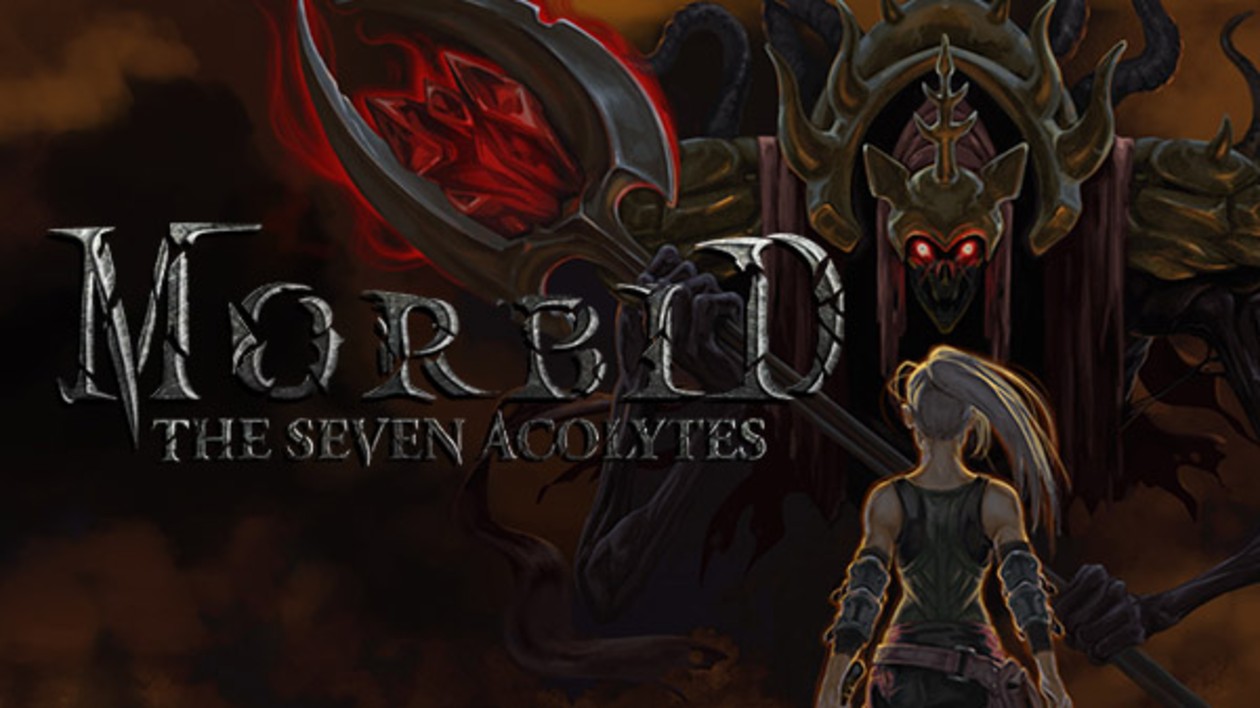A top-down 2D Souls-like that’s as gruesome as it is difficult, Morbid The Seven Acolytes is also relatively accessible for the genre. The Finger Guns Review:
Despite what it might look like, Morbid: The Seven Acolytes falls squarely into the genre of the Souls-like. Slow methodical swordwork, perfectly timed dodges and parries, horrific multi-stage bosses who can kill you at a single moment’s inattention. It’s the Souls-like and it’s some people’s idea of a good time, and other people’s idea of a nightmare. But it’s not only a Souls-like – it’s also got gunplay, making it look a little like a pixelart top-down Bloodborne, the world is a bleak wasteland that reminds me of Hyper Light Drifter, and it has some elements of a roguelite.
Converting the Souls-like gameplay into the 2D space has been tried with varying success in the side-scrolling format, with Blasphemous, Death’s Gambit, and Salt and Sanctuary (and maybe Hollow Knight) to name a few of the more memorable, but to a far lesser extent the top-down variety. There have been a few but none that have really shone.
So Morbid: The Seven Acolytes debuts into a largely untapped space for the Souls genre. It’s minimalist, never giving more story or plot than it feels necessary, but lore-rich, much like the games it homages and seeks to convert to a new plane. It gives you just what you need to survive and no more, making you rely instead on your own strategies, ingenuity and skill. Oh, and it’s really damn difficult.

Long ago the Gahars, a race of tormented god-like spirits, bound their souls to the flesh of the Seven Acolytes, using them as hosts, without whose flesh they would perish. They plunged the land and it’s people into slavery, destitution and madness. Everything has been corrupted by them and the blood flesh that reanimates corpses, creatures and plants. Their reign of terror must be stopped.
You play as the last of an order of warriors, the Strivers of Dibrom, sworn to destroy the Gahars, and therefore the acolytes. Masters of both melee and ranged combat, many Strivers have come before you and failed. Now you are the last. You wake after a shipwreck, in a land of death. Barrels of flesh and blood, plants that burst with blood sacs, and demons reanimating the decaying flesh of the lost. It’s all pretty morbid, really.
As with many other games in the souls genre, plot takes a back seat to exploration. You know your mission and you’re left to find your own way to complete it. I found the drive to take out the Seven Acolytes was strong enough to take me most of the way. Actually saying there are seven helps me to get through a souls game, like knowing how many more are left to find and kill in the Cult of Kosmos in AC Odyssey, rather than that intangible murk ahead of you in usual Souls games – how many more bosses do I have to fight!? There are indeed seven epic and grotesque bosses, but also five mini-bosses that are plenty tough and enemies throughout the world that can kill you easier than the bosses.
Items and scattered books will be your only means of learning the ropes as a player, but also of piecing together the rich lore and myth of Mornia. It’s tangible and deft world-building even if it is on the more minimalist side. This can be a good thing – there’s less to read, but what’s there is more impactful. I’m normally one for plot, but here the lack of it was not much of a hinderance.
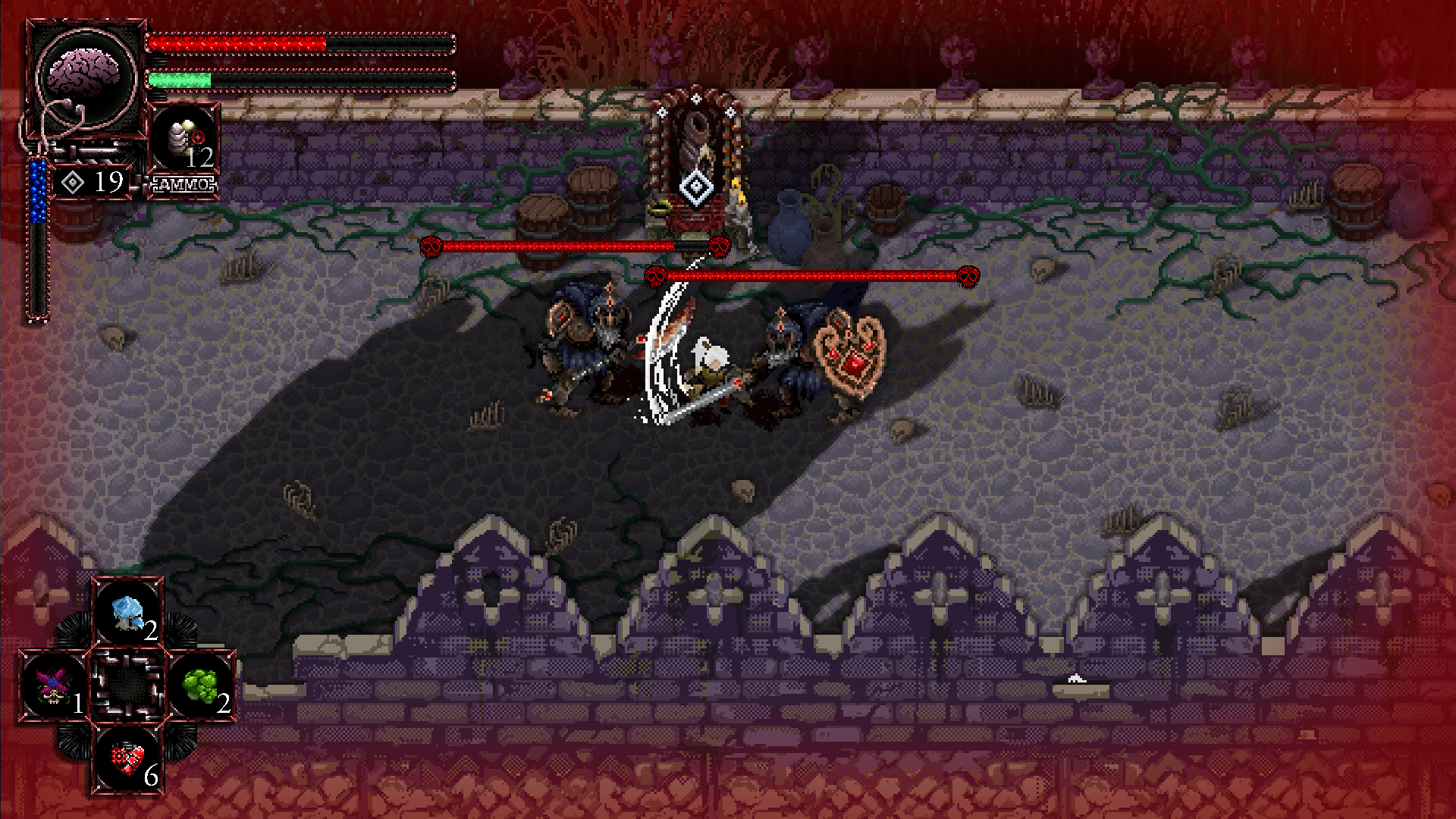
Obviously the first thing everyone’s going to want to know is, does it play like a Soulsborne game? Well yes, but also no. It’s got the parries and dodges, the slow methodical swordplay and stamina gauge. They’re all there and they’re all causing as much agro as usual. But there’s an element missing, or you might describe this as better, depending on you point of view. As you defeat enemies you gain, not really souls, but a kind of brain fluid that fills up a gauge and gives you skill points. If you die before you reach the shrine, you don’t lose everything – you keep what you’ve accumulated. No need to go back through the level and find the spot where you died to recover anything. It’s a Souls-like, but one where you keep your progression. Souls-lite? Is that a thing?
The skill points are locked until you have taken out the first of the Acolytes, about two hours in. You’ll then unlock blessings which are different buffs, like increases to health and stamina bars, or more potent heals from the stone of Dibrom – the healing function. You can equip a number of these blessings (one more for every acolyte you kill) and you can upgrade them using the accumulated skill points you gain (and don’t lose) as you play.
The world of Mornia is split into a dozen or so murky regions, from putrid swamps to dying forest, from desolate farmland to destitute villages, each sporting a massive interlinked maze to get lost in as you slowly make your way to the next Acolyte. You’ll fight the general enemies, all quite capable of death dealing within a couple of hits. Combat comprises of swordplay, with a basic hit and a special that takes longer to perform, dodging and parrying, and your gun. There are a couple dozen different weapons to find, each with its own nuance; some slowing your attacks but giving you more power or range, others making you fast, but requiring you to close the distance to make the most of that speed. Generally it’s a nuanced and competent system that does a lot with only a small amount of moves per weapon.
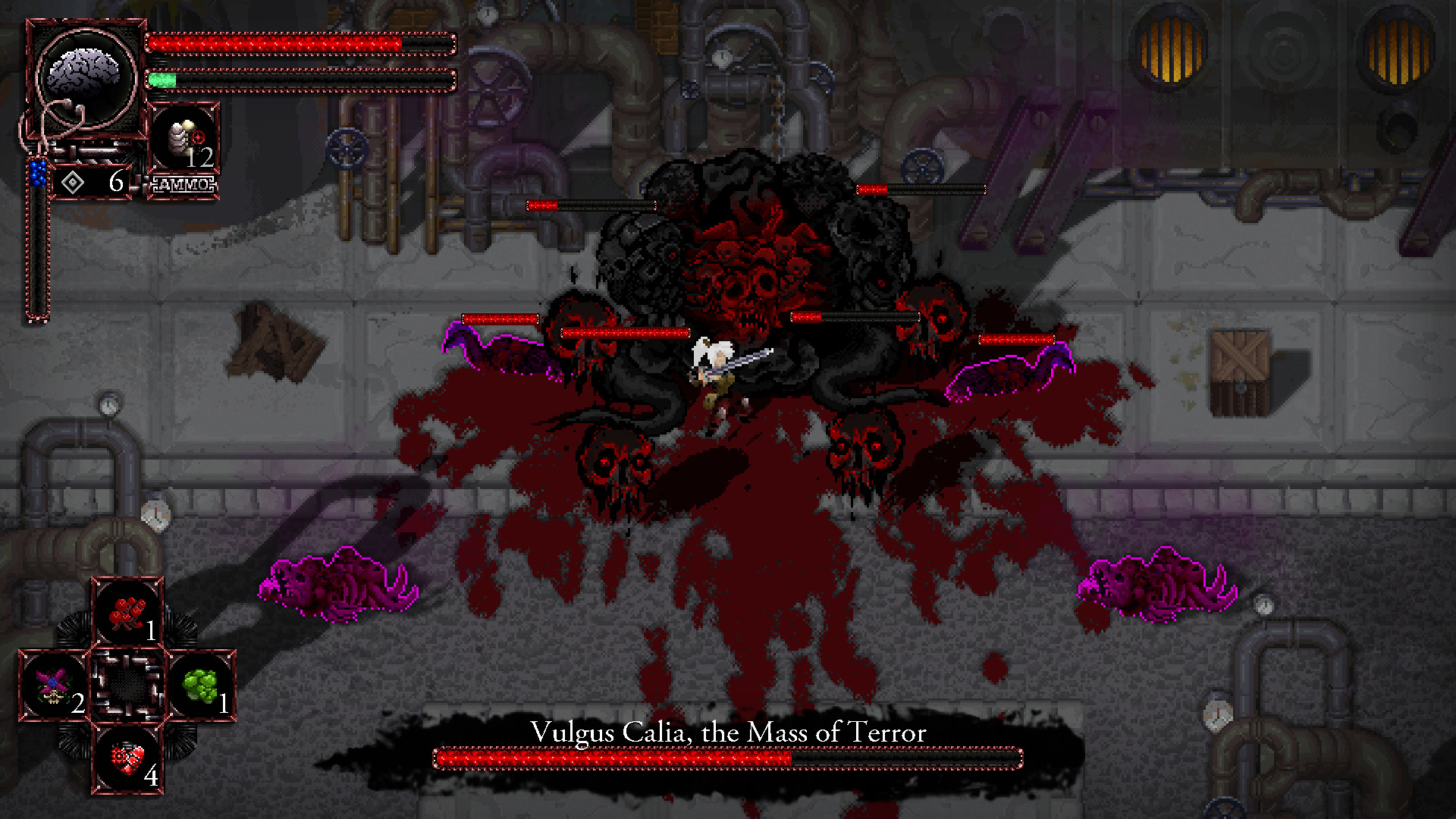
Depending on the Souls-like game, dodging or parrying will be extremely important. Sometimes its both. Here dodging felt to me the far more necessary and usable skill. Parrying is extremely tight, and must be triggered very late, and generally took a back seat in my playstyle to dodging.
It’s also a lot about timing your rolls and the lead in time for your special. Time your dodge rolls and you can roll right through hard-hitting attacks, time your special with a great sword for the moment after a boss’ big attack, or for the right amount of space an enemy needs to cross to approach and attack and they’ll walk straight into it.
In addition to health and stamina, Morbid: The Seven Acolytes introduces a third gauge to manage – Insanity. The gruesome world and its creatures could send anyone loopy, and once that gauge fills, the screen turns veiny purple. Continue to fight in this state and anything you kill can resurrect as a ghost of your subconscious, equally if not more able to slice you apart. There are plentiful items around to help you manage your insanity, or overload it and get a perk, but overall I found this element rarely happened if I was diligent, to the point it felt almost unnecessary.
The other aspect that I didn’t find gel for me was the gunplay. Like Bloodborne, you have a gun with you on this adventure and you have the same constraints on ammunition. Fire off a few shots during a boss to help whittle down their health, or to pick off annoying enemies that are hard to hit. It’s performed like an analog stick shooter with the right stick, and a press of the shoulder button. I found even with extra enhancements none of the guns made such an impact on battles that I couldn’t have done better just melee attacking. The damage is negligible and the only times I found it useful were a couple of fights where a boss was aided by minions and you could take them out at range. With blessings and runes enhancing the weapons you may find the guns more useful towards the final dungeons.
Morbid also allows for a certain amount of stealth, letting you sneak by holding the left shoulder button, and deal a special attack blow to start your fight. This starts off cool, but then you begin to realise it’s overpowered. The enemies have no real awareness, behind or in front, you can sneak up to them from the front and attack just as easily as from behind. Enemies can ignore you running right by them and suddenly become interested when you’ve done nothing to provoke it. It means that sneaking, coupled with pretty dopey awareness AI, allows you to knock a lot of enemies senseless before they can react.
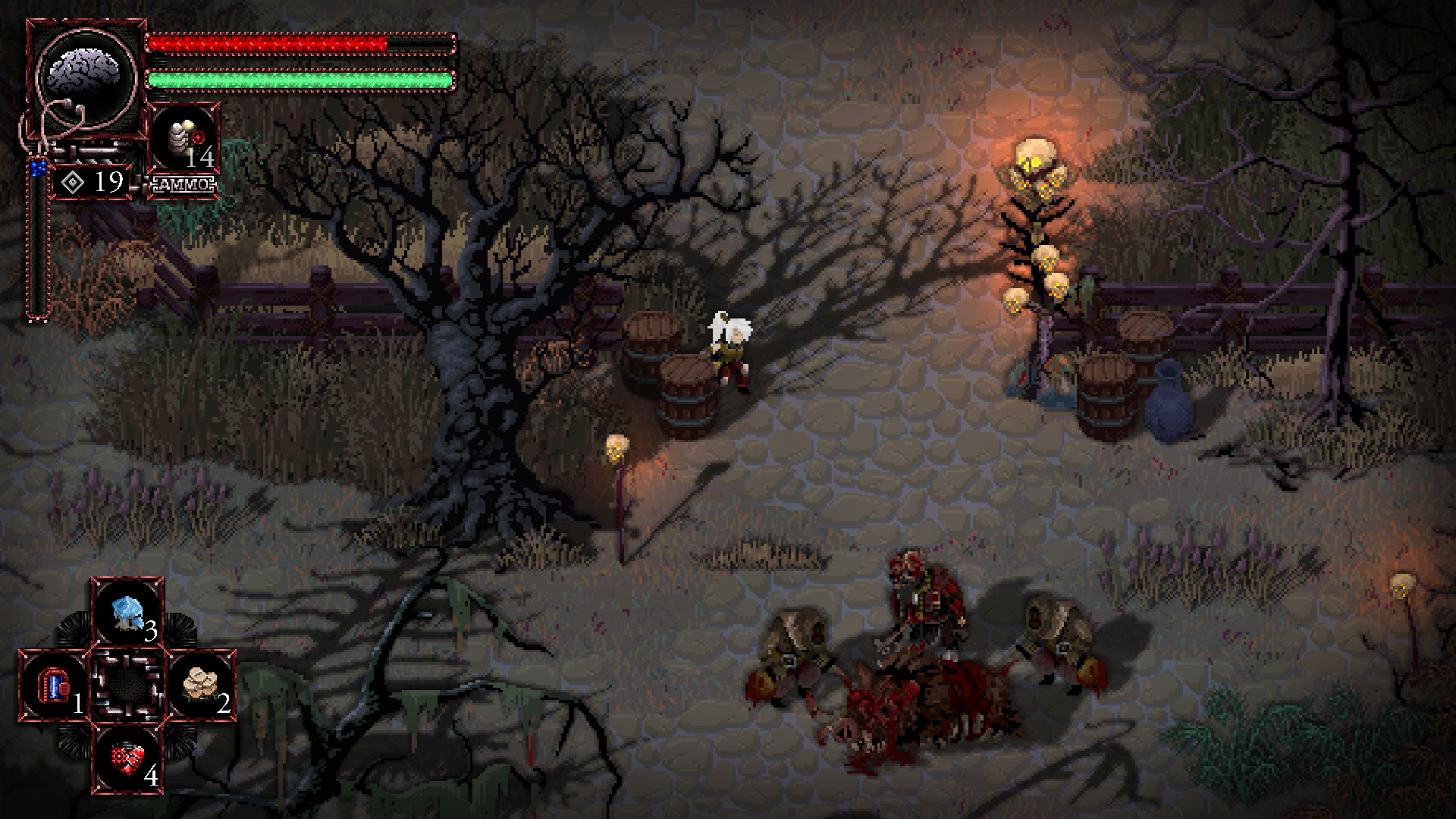
Morbid: The Seven Acolytes is definitely difficult, but it’s difficult in the same way as all souls-like games are. Learn the patterns and the tells of your enemies and you will soon be able to dodge and perhaps even parry with skill. Every enemy can destroy you, and every boss is a challenge, but I don’t think it’s on the level of the hardest Souls bosses out there. A few of the later bosses require absolute finesse on the parry button, which can be a very tricky move to master, but you’ll need to if you’re going to take out the last of the acolytes.
There’s also a sort of cheese (cheap tactic) possible that’s baked into the way the graphics interact with each other. Imagine a tall boss creature on screen. His head is the topmost part of his body and in a 3D game you’d never be able to hit it. But because of the nature of the graphics and the 2D world, his head is also touching the floor, just further up the screen, right? Position yourself higher up the screen and you can hit the head of the beast while you are still basically out of range of their attacks lower down the screen. Obviously it doesn’t work on everything, but the larger the boss, the more surface area they cover. It can be easy to hit things and not get hit yourself.
Graphically Morbid: The Seven Acolytes does what it sets out to do. It’s a pixelart grotesquery and there’s blood everywhere. The world of Mornia is pretty muted all told, but that’s very in keeping with the Lovecraftian and gothic mix of styles, and the Souls genre in general. The pixelart on offer is good, and evokes the sense of foreboding darkness that I think they were going for.
There are a dozen or so themes that play during bosses, or exploration, each one a mix of choirs and soft strings that give Mornia a melancholy and ominous edge. It’s similar in style to the Bloodborne soundtrack so if you enjoyed that gothic heaviness, you’ll like this one too. There’s also a couple of bangers in there, with stabby metal riffs, including the menu music, that give off a great vibe.
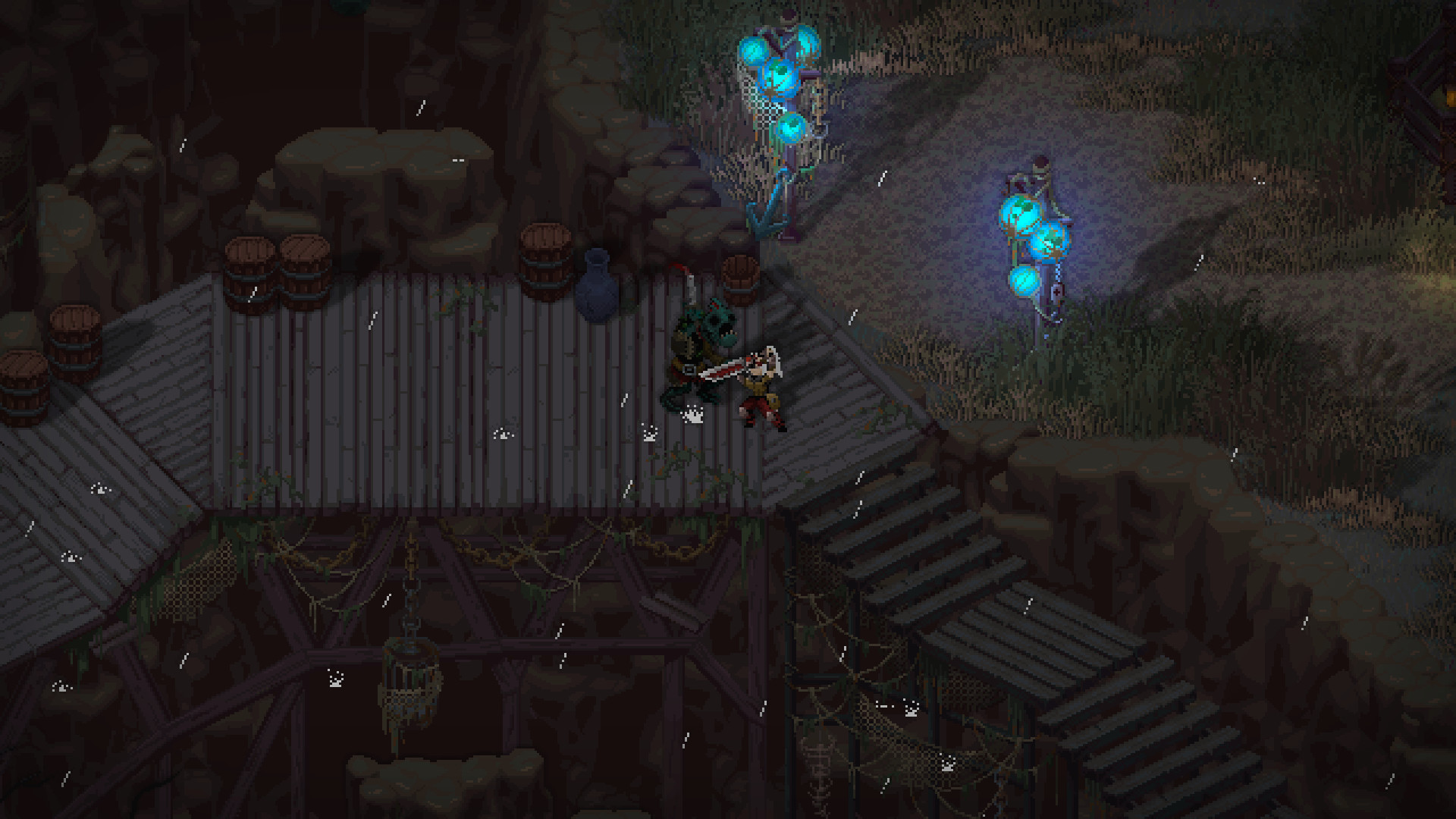
Morbid: The Seven Acolytes isn’t without a few issues. The item screen can get tiresome to manage. You are given a grid system, with items taking up a certain amount of squares and space. No items can be rotated or placed horizontally, and so even if you have multiple free squares the game will not allow you to pick large things up without creating the exact space necessary. It’s also constantly overloading you with runes, when most weapons will only take two or so.
You can only hold ten of each item and there’s more than just one type of healing item. Once you have ten it’s a waste not to just keep using them as you find them. You can crack open those vials and get regen going quite often, leading to you being able to gain health relatively easily.
It’s also gruesome. The clue’s in the title. There’s copious amounts of blood, far more than in most games. If your mum sees you playing this, she’s going to have issues with it in the same way she would with Hotline Miami, or Mortal Kombat. Keep it hidden, kids.
It would have been a nice addition to be able to redo the bosses. There is an achievement for killing an acolyte without taking damage, and by the end of the game you could manage this. Only problem is no way to redo the bosses. Please add this in as a patch!
At time of writing, the Xbox One version had a Fatal Error glitch, that would happen if you tarried too long in the Shrine menu. The game glitches out, spewing dissonant sound and then crashing. Not fun with your headphones on.
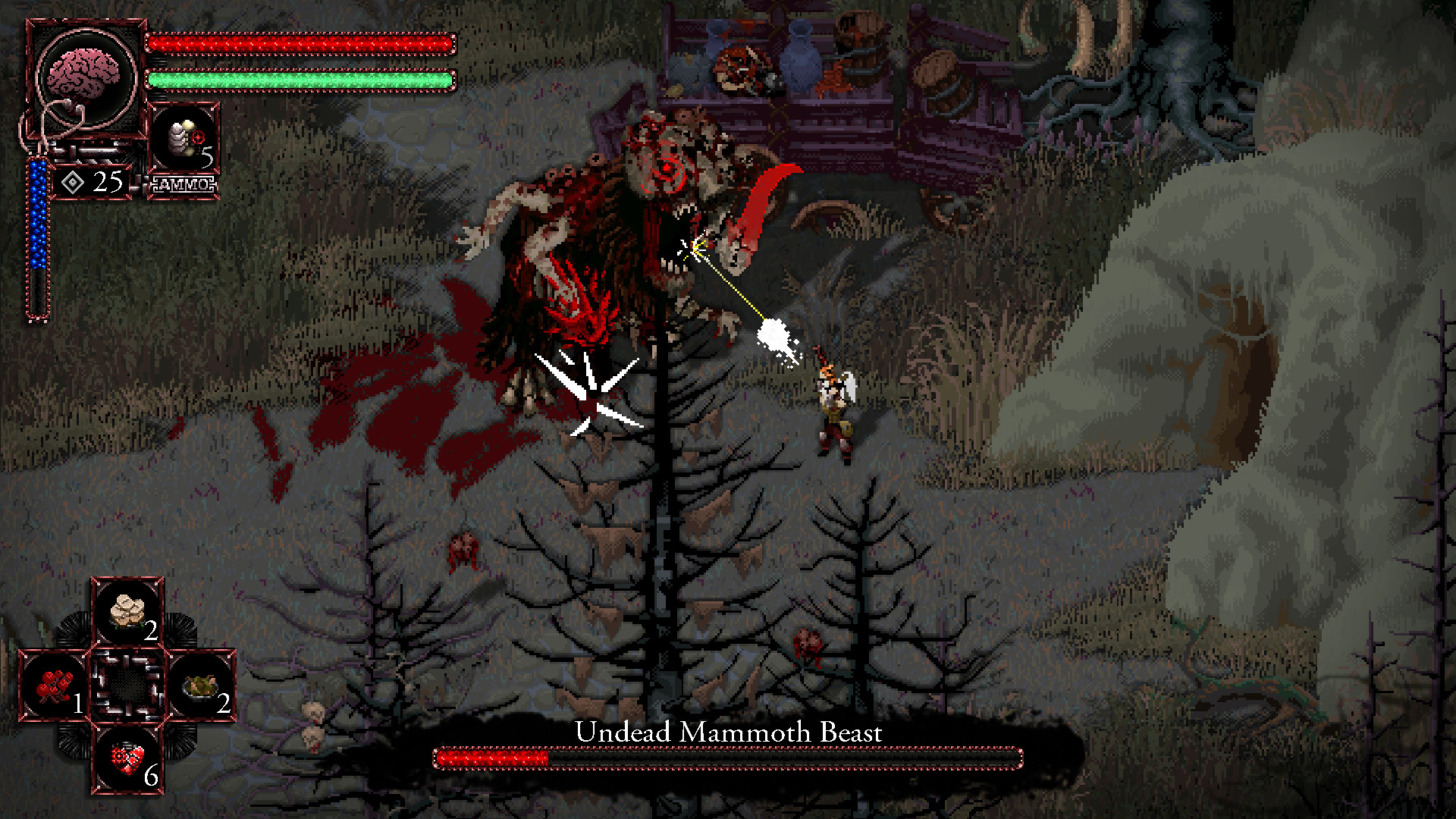
Morbid: The Seven Acolytes is a competent and intriguing foray into top-down 2D for the Souls-like genre. I hope it’s followed by more, as it’s a style that I really enjoy. Pixelart and souls is a match that will appeal to many. The world of Mornia is interesting to explore, and the lore is rich enough to keep you pushing forward for its 15 or so hours.
It manages to create a fun and usable combat system with a very minimalist moveset, but possibly suffers when compared to more established souls games that have more combos and moves depending on weapon. In Morbid there is a different movement for pikes, and swords rather than melee gloves, but they pretty much feel the same, just with different speeds and range. If any souls fans are on the fence, it has the same tough but fair difficulty that they will enjoy even with the much more simplistic moveset.
Mornia is a top-down 2D pixelart world that is a gruesome joy to explore and attempt to liberate. It’s difficulty will put some off, but Morbid: The Seven Acolytes is a competent and accessible souls-like experience, that gives everyone a level playing field with its minimalist systems and simple move sets.

Morbid: The Seven Acolytes is available 3rd December 2020 on Xbox One (review platform), PS4, Nintendo Switch and PC via Steam.
Developer: Still Running
Publisher: Merge Games
Disclaimer: In order to complete this review, we received a promotional copy of the game. For our full review policy, please go here.
If you enjoyed this article or any more of our content, please consider our Patreon.
